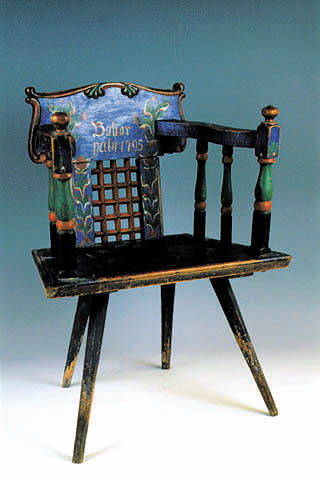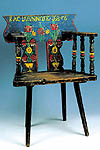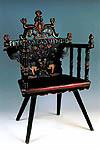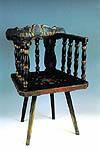 |
|
Ethnographical research of furniture had an impact on
society between the two World Wars – though rather unpronounced than pronounced.
However, this only became a regular requirement after 1945. In the hall
we exhibit the so-called „gondolkodószék” („armchairs for thinking”), that
were used in a certain period and region (18–19 century, southern part
of the Great Hungarian Plain) by wealthy families of a certain social situation
and reserved for the householder. Social impact of these objects was so
great that poor people eventually having obtained one of them didn’t generally
use them. The name of the owner is often written on them.
„It seems that we should consider it an exceptional occurrence
that our object had taken root in the villages of the southern part of
the region beyond the Tisza – but from here we have a piece from a peasant
house in Békéscsaba dating from as early as 1774. I think what I have experienced
during my fieldwork in the neighbourhood of Dunapataj is a more characteristic
feature of other regions of the Great Hungarian Plain. In particular: we
could find board-backed chairs only – apart from other forms, dating from
later periods – in the villages situated in the outskirts of the former
market-town, and there was not the slightest evidence for the existence
of armchairs in the likewise Calvinistic Ordas, a village bearing close
resemblance to Dunapataj, occasionally even merging with it, neither at
the catholic dwellers around Kalocsa, or in Harta, where German – otherwise
protestant – inhabitants lived, settled down there in the 18th century.”
K. Csilléry Klára: A lakáskultúra társadalmi rétegek szerinti
differenciálódása. [The Differentation of Home-furnishing Based on Strata
of Society.] Ethnographia XCVI(2–3). 1985, 198–199. p.
For more information click on the pictures! |



